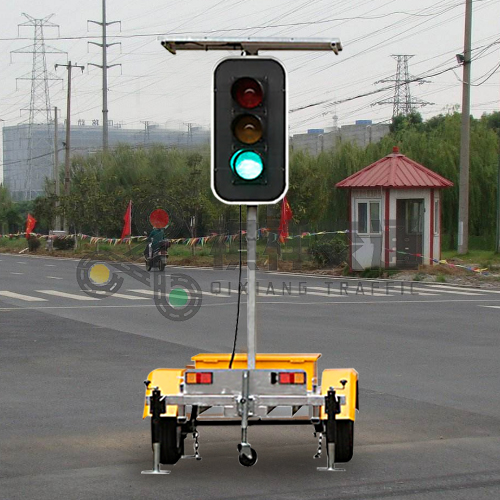Service life of a portable traffic light is the period during which the traffic light system is expected to operate effectively and provide reliable service. The determination of the service life of a portable traffic light is affected by a variety of factors, including the design and construction of the device, the quality of materials used, maintenance practices, environmental conditions, and technological advances. Portable traffic lights are an important tool for managing traffic flow and ensuring safety in a variety of situations, including construction zones, temporary road closures, and maintenance activities. Understanding the factors that affect the service life of these devices is critical to effective deployment and resource planning. In this article, we will explore the different aspects that affect the service life of portable traffic lights and discuss best practices for maximizing their service life.
1. Design and construction
The design and construction of a portable traffic light play an important role in determining its service life. High-quality materials, durable components, and sturdy construction help extend the life of your device. Additionally, using modern, reliable technology in the design of portable traffic lights can improve their performance and reliability over time. Factors such as waterproofing, impact resistance, and durability of electrical and electronic components are important considerations during the design phase.
2. Maintenance practices
Regular maintenance and proper care are essential to extend the life of your portable traffic light. Maintenance practices may include routine inspections, cleaning, electrical system testing, and optical signal calibration. Adhering to the manufacturer’s maintenance guidelines and schedules is critical to preventing premature wear and ensuring your equipment continues to operate optimally. Additionally, addressing small issues promptly can prevent them from developing into larger problems that could shorten the life of your traffic light system.
3. Environmental conditions
The environment in which a portable traffic light is deployed can significantly affect its service life. Exposure to extreme weather conditions, such as intense sunlight, heavy rain, snow, and temperature fluctuations, can accelerate the aging of your equipment. Environmental factors can also affect the integrity of electrical connections, housing materials, and the visibility of optical signals. Therefore, selecting portable traffic lights with appropriate weatherproofing and considering environmental factors during deployment can help mitigate the impact of adverse conditions on the equipment’s service life.
4. Usage and traffic conditions
The frequency and intensity of use, as well as the specific traffic conditions in which portable traffic lights are used, will affect their service life. Equipment subject to heavy traffic, frequent relocations, or long periods of operation may experience greater wear and tear than systems used in low-traffic or intermittent scenarios. Understanding expected usage patterns and traffic conditions is critical to selecting the most appropriate portable traffic light and estimating its expected service life.
5. Skill improved
Advances in technology and industry standards can affect the service life of portable traffic lights. This new generation of traffic control equipment offers greater efficiency, reliability, and durability than earlier models. As technology continues to evolve, older equipment may become obsolete or less cost-effective to maintain. Therefore, considering the pace of technological advancement and assessing the potential impact on the service life of portable traffic lights is critical for long-term planning and investment decisions.
6. Regulatory compliance and safety standards
Compliance with regulatory requirements and compliance with safety standards are also key factors in determining the service life of portable traffic lights. Equipment that meets or exceeds industry standards for performance, durability, and safety features is likely to have a longer service life. In addition, regular inspections and certifications to ensure compliance with applicable regulations help improve the overall reliability and longevity of traffic light systems. Maximize the life of portable traffic lights To maximize the service life of portable traffic lights, best practices must be implemented in their selection, deployment, maintenance, and operation.
Here are some key strategies to ensure the longevity of your portable traffic lights:
A. Quality Assurance:
Prefer high-quality, durable traffic control equipment from reputable manufacturers with a proven track record of reliability and performance.
B. Proper installation:
Follow recommended installation procedures to ensure the traffic light is securely mounted and to prevent potential damage or vandalism.
C. Routine Maintenance:
Develop a regular maintenance schedule that includes visual inspections, cleaning, component testing, and replacement of worn or damaged parts as needed.
D. Environmental Protection:
Deploy portable traffic lights with environmental considerations in mind and utilize protective measures such as weatherproof housing and secure mounting to mitigate the effects of harsh conditions.
E. Training and Awareness:
Provide training to those responsible for operating and maintaining portable traffic lights to ensure they understand proper use, handling, and safety precautions. Monitoring and performance evaluation: Implement a system to monitor the performance of portable traffic lights, conduct regular evaluations, and resolve any issues promptly to prevent potential failures.
F. Replacement Plan:
Develop a long-term strategy for equipment replacement and technology upgrades to accommodate advances in traffic control systems and minimize the risk of equipment obsolescence. By incorporating these best practices into the management of portable traffic lights, transportation authorities, construction companies, and other stakeholders can optimize the service life of the equipment and ensure the reliable operation of traffic control systems.
In summary, the service life of portable traffic lights is affected by a variety of factors, including design and construction quality, maintenance practices, environmental conditions, usage patterns, technological advancements, and regulatory compliance. By considering these factors and implementing best practices for equipment selection, deployment, and maintenance, stakeholders can maximize the service life and reliability of portable traffic lights, helping to improve traffic management and safety.
Post time: Jan-05-2024







